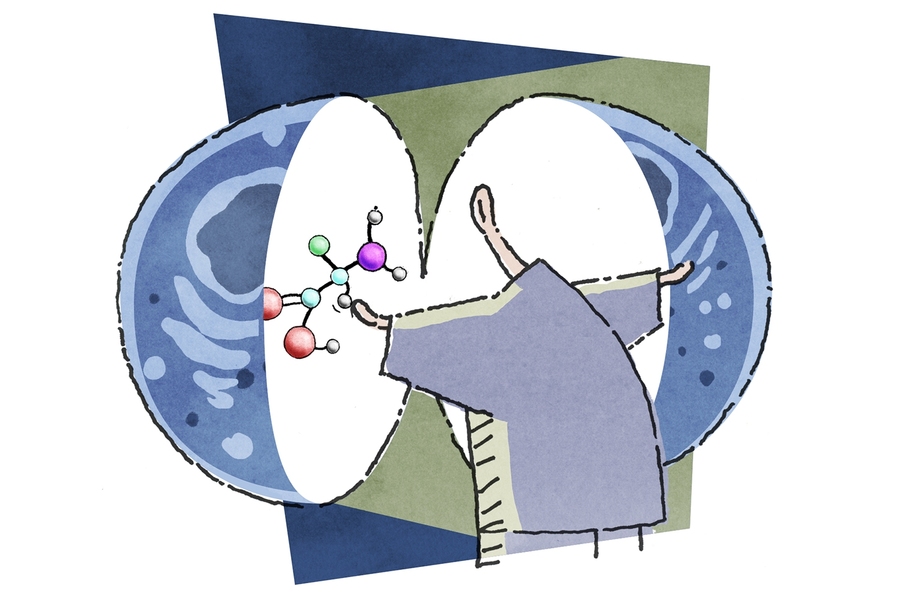To survive and grow, a cell must properly assess the resources available and couple that with its growth and metabolism — a misstep in that calculus can potentially cause cell death or dysfunction. At the crux of these decisions is the mTOR pathway, a cellular pathway connecting nutrition, metabolism, and disease.
The mTOR pathway incorporates input from multiple factors, such as oxygen levels, nutrient availability, growth factors, and insulin levels to promote or restrict cellular growth and metabolism. But when the pathway runs amok, it can be associated with numerous diseases, including cancer, diabetes, and Alzheimer’s disease. Understanding the various sensors that feed into the mTOR pathway could lead to novel therapies for these diseases and even aging, as dialing down the mTOR pathway is linked to longer lifespans in mice and other organisms.
Although the essential amino acid methionine is one of the key nutrients whose levels cells must carefully sense, researchers did not know how it fed into the mTOR pathway — or if it did at all. Now, Whitehead Institute Member David Sabatini and members of his laboratory have identified a protein, SAMTOR, as a sensor in the mTOR pathway for the methionine derivative SAM (S-adenosyl methionine). Their findings are described in the current issue of the journal Science.
Methionine is essential for protein synthesis, and a metabolite produced from it, SAM, is involved in several critical cellular functions to sustain growth, including DNA methylation, ribosome biogenesis, and phospholipid metabolism. Interestingly, methionine restriction at the organismal level has been linked to increased insulin tolerance and lifespan, similar to the antiaging effects associated with inhibition of mTOR pathway activity. But the connection between mTOR, methionine, and aging remains elusive.
“There are a lot of similarities between the phenotypes of methionine restriction and mTOR inhibition,” says Sabatini, who is also a Howard Hughes Medical Institute investigator and a professor of biology at MIT. “The existence of this protein SAMTOR provides some tantalizing data suggesting that those phenotypes may be mechanistically connected.”
Sabatini identified mTOR as a graduate student and has since elucidated numerous aspects of its namesake pathway. He and his lab recently pinpointed the molecular sensors in the mTOR pathway for two key amino acids: leucine and arginine. In the current line of research, co-first authors of the Science paper Xin Gu and Jose Orozco, both graduate students Sabatini’s lab, identified a previously uncharacterized protein that seemed to interact with components of the mTOR pathway. After further investigation, they determined that the protein binds to SAM and indirectly gauges the pool of available methionine, making this protein — SAMTOR — a specific and unique nutrient sensor that informs the mTOR pathway.
“People have been trying to figure out how methionine was sensed in cells for a really long time,” Orozco says. “I think that this is the first time in mammalian cells a mechanism has been found to describe the way methionine can regulate a major signaling pathway like mTOR.”
The current research indicates that SAMTOR plays a crucial role in methionine sensing. Methionine metabolism is vital for many cellular functions, and the Sabatini lab will further investigate the potential links between SAMTOR and the extended lifespan and increased insulin sensitivity effects that are associated with low methionine levels.
“It is very interesting to consider mechanistically how methionine restriction might be associated in multiple organisms with beneficial effects, and identification of this protein provides us a potential molecular handle to further investigate this question,” Gu says. “The nutrient-sensing pathway upstream of mTOR is a very elegant system in terms of responding to the availability of certain nutrients with specific mechanisms to regulate cell growth. The currently known sensors raise some interesting questions about why cells evolved sensing mechanisms to these specific nutrients and how cells treat these nutrients differently.”
This work was supported by the National Institutes of Health, the Department of Defense, the National Science Foundation, and the Paul Gray UROP Fund.








